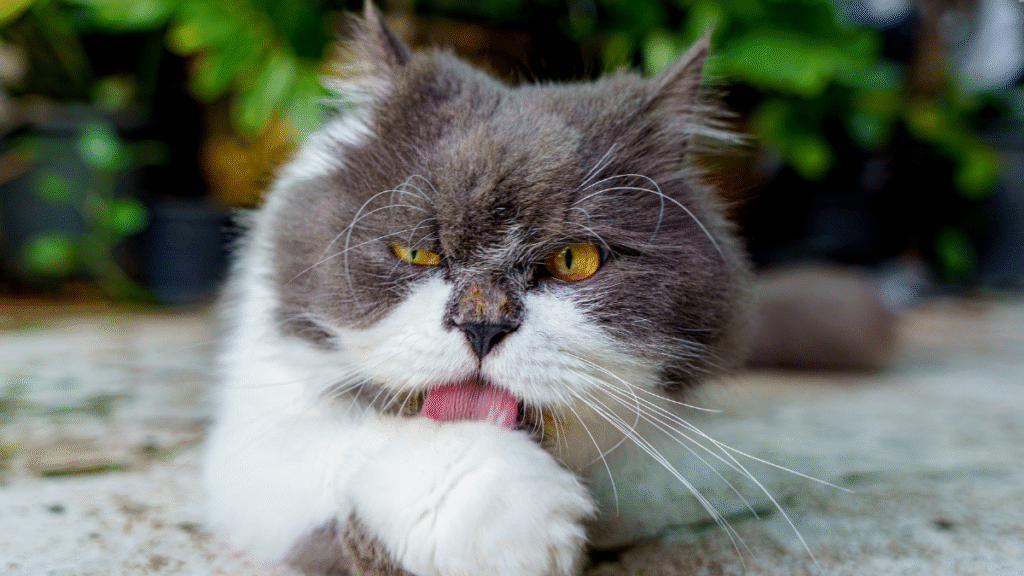Few things are as satisfying as seeing your Persian cat looking their absolute best — their long, silky fur perfectly brushed, and their serene, royal face radiating calm elegance.
But achieving that show-stopping level of maximum fluff takes effort. Brushing, trimming, bathing, and regular upkeep are all essential to keep your cat’s coat looking gorgeous and feeling soft.
Whether you’re preparing your Persian for a show or photoshoot, or simply want them to be as fluffy and comfortable as possible at home, dedicating time to a full Persian cat spa day can work wonders.
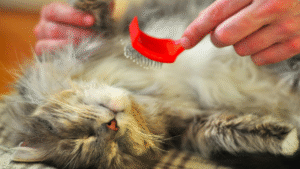
About the Persian Cat’s Coat
Before we get into grooming, let’s talk about your Persian cat’s beautiful coat and why it needs special attention. Persian cats are long-haired felines with dense double coats — a short, soft undercoat topped with long, silky fur. This combination makes them so fluffy and glamorous, but it also makes them more prone to tangles, mats, and shedding.
Their fur can trap dirt, oils, and debris much more easily than that of short-haired cats. Daily brushing and regular baths are vital not just for your cat’s appearance but also for their overall health. Neglecting a Persian’s coat can lead to painful mats, skin irritation, and even infections. That’s why a consistent grooming routine is essential.
Planning Your Cat’s Spa Day
Before you begin, take time to plan your cat’s full grooming session so you have all the supplies and enough time to make the experience relaxing for both of you.
Choose a calm space: Find a quiet room with no loud distractions or frequent traffic. Your cat should feel safe and secure.
Prepare your grooming tools: You’ll need a metal comb, slicker brush, grooming scissors, cat-safe shampoo, conditioner, towels, and a blow dryer.
Reward your cat: Offer small treats after each step so your cat associates grooming with comfort and affection.

Cat Spa Grooming Routine
Follow this step-by-step guide to transform your cat from a little dusty to their full, fluffy potential.
Step 1: Brushing for a Fluffy Coat
Brushing is the most crucial part of grooming a Persian cat’s coat. It should be done daily or at least several times a week.
Tools to Use:
-
Wide-tooth metal comb: Ideal for working through larger mats.
-
Slicker brush: Helps remove loose hair and smooth the topcoat.
-
Soft bristle brush: Perfect for finishing and adding shine.
Method:
-
Start by gently running your fingers through your cat’s fur to locate any knots.
-
Use the wide-tooth comb to loosen tangles, working from the ends toward the roots.
-
Follow up with the slicker brush, brushing in the direction of hair growth.
-
Finish with the soft bristle brush to add smoothness and extra fluff.
Brushing removes loose fur, prevents tangles and mats, and evenly distributes natural oils to keep the coat shiny and healthy. It’s also a wonderful bonding experience. With patience, most Persians learn to enjoy brushing.
Step 2: Bathing Your Persian Cat
Contrary to popular belief, Persian cats don’t necessarily hate baths. In fact, regular bathing helps keep their long fur clean, soft, and free from excess oil and tangles. The key is to make the process calm and positive. Bathe your cat every 3–6 weeks for best results.
How to Bathe:
-
Trim your cat’s nails beforehand to prevent scratches.
-
Place a rubber mat in the tub or sink to prevent slipping.
-
Use lukewarm water — never too hot or cold.
-
Have towels and a blow dryer ready before you begin.
Choosing the Right Shampoo:
Select a cat-safe, sulfate-free shampoo. Oatmeal-based or whitening shampoos work well for long-haired breeds. You can also use a conditioner or detangling spray for added softness.
Bathing Process:
-
Thoroughly wet your cat’s fur from neck to tail, avoiding the head.
-
Apply shampoo evenly, working it into a lather and massaging down to the skin.
-
Rinse thoroughly to remove all suds, as residue can irritate the skin.
-
Apply conditioner (optional), leave it on for about a minute, then rinse again.
-
Wrap your cat in a towel and gently squeeze out excess water — never rub vigorously.
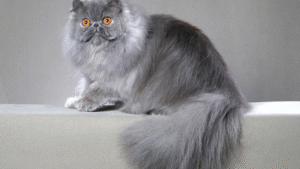
Step 3: Blow Drying for Maximum Fluff
Persian cats should never be left to air dry after a bath. Their thick coats can take hours to dry, which can cause mats, chills, or even a musty odor.
Drying Process:
-
Use a pet-safe blow dryer on low heat and low speed.
-
Brush through the fur while drying to prevent tangles.
-
Start with the belly and legs, then move to the back and tail.
-
Finish with the head and neck last, as these are sensitive areas.
Proper drying helps “set” the coat, creating that voluminous, cloud-like finish every Persian owner loves.
Step 4: Trimming the Fur
Trimming is the final step in Persian cat grooming and can be intimidating for beginners. If you’re unsure, especially with sanitary trims or lion cuts, it’s best to consult a professional groomer.
Areas to Trim:
-
Eyes: Persian cats often have tear stains due to their flat faces. Use a soft, damp cloth or cat-safe wipes daily to clean around the eyes.
-
Paws: Trim the fur between the paw pads to prevent dirt buildup.
-
Rear area: Keep this area short for hygiene, especially for cats with fluffy tails.
Trimming helps prevent matting and keeps your cat clean and comfortable.
Step 5: Ear, Eye, and Nail Care
Don’t overlook these finishing touches — they’re key to your cat’s comfort and hygiene.
Ears: Check weekly and gently wipe the inner ear with a damp cotton pad or cat ear cleaner. Never insert anything deep into the ear canal.
Eyes: Clean around the eyes daily using a soft wipe or cotton pad soaked in warm water. Avoid alcohol or scented products.
Nails: Trim your cat’s nails every 2–3 weeks using cat nail clippers. Only clip the sharp tips to prevent overcutting.
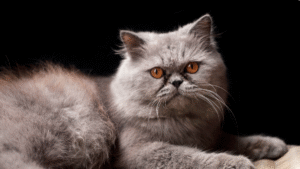
Step 6: Diet and Hydration for Coat Health
A Persian cat’s coat health starts from within. A balanced diet and proper hydration directly affect the quality, shine, and softness of the fur.
Tips:
-
Choose high-quality cat food rich in omega-3 and omega-6 fatty acids.
-
Include natural oils from sources like salmon or flaxseed.
-
Ensure your cat drinks plenty of fresh water every day.
-
Consult your vet about supplements for skin and coat health.
Step 7: Establish a Regular Grooming Schedule
Consistency is key when caring for a Persian cat’s coat. Set a routine that works for both of you:
-
Daily: Brushing, eye cleaning, light detangling
-
Weekly: Ear cleaning, paw and nail checks
-
Every 3–6 weeks: Full bath and blow-dry
-
Monthly: Trimming as needed
Following this schedule will keep your Persian’s coat mat-free, shiny, and healthy all year long.
When to Visit a Professional Groomer
Even the most diligent cat owners sometimes need professional help. You should consider professional grooming if:
-
Your cat’s fur has severe mats.
-
You’re unsure how to trim safely.
-
Your cat becomes anxious or aggressive during grooming.
Professional groomers have specialized tools and experience with long-haired breeds like Persians, ensuring a safe and thorough grooming experience.
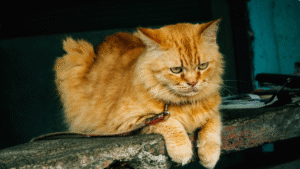
Common Grooming Mistakes to Avoid
No one is perfect when it comes to pet grooming, but these common mistakes can cause problems:
-
Skipping regular brushing: Mats can form in just a few days.
-
Using human shampoo: It can dry out or irritate your cat’s skin.
-
Overbathing: Too many baths strip natural oils.
-
Rough drying: Always dry gently and patiently.
-
Poor diet: Low-quality food leads to dull fur and excessive shedding.
Final Thoughts
Caring for a Persian cat’s luxurious coat requires time and dedication, but the results are worth it. Regular brushing, bathing, trimming, and proper nutrition ensure your cat stays comfortable, clean, and irresistibly soft.
With patience and consistency, your Persian’s coat can achieve that enviable, cloud-like fluff — the true mark of a healthy, happy, and well-loved cat.
- Homemade Calming Spray To Help Dogs During Training - November 12, 2025
- 7 DIY Dog Training Tools You Can Make From Household Items - November 12, 2025
- How To Make Your Own Clicker For Dog Training - November 12, 2025
